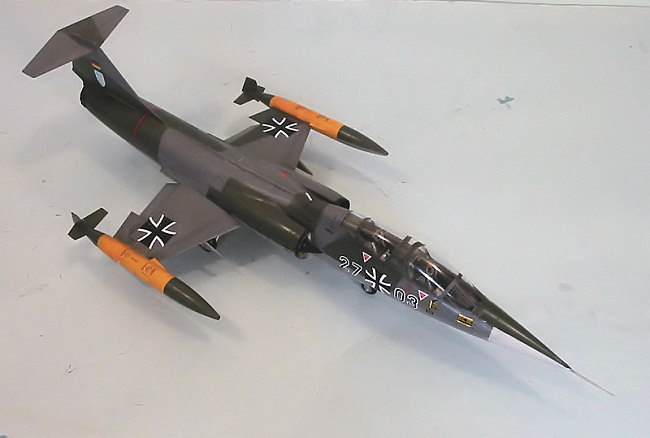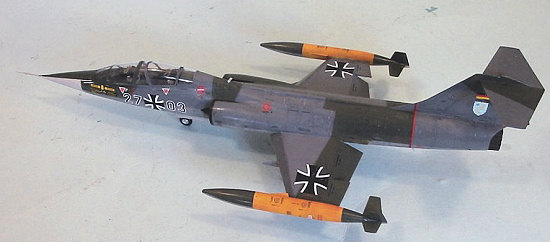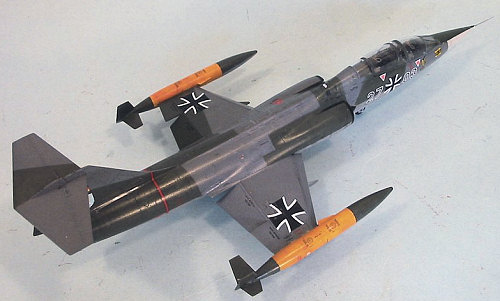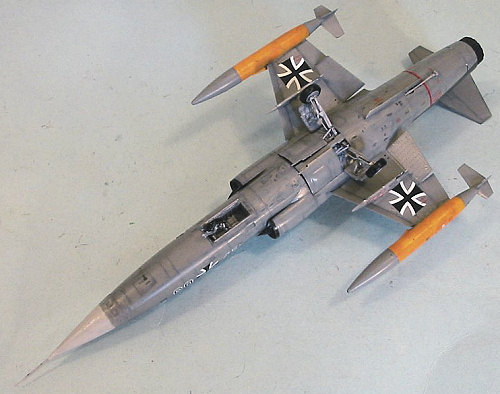
| KIT: | Hasegawa 1/48 TF-104G Starfighter |
| KIT #: | 07240 (Pt40) |
| PRICE: | 2800 yen at www.hlj.com |
| DECALS: | Two Options |
| REVIEWER: | Tom Cleaver |
| NOTES: |

| HISTORY |
To my mind, far more interesting than the operational history of the F-104G is the tale of how it came to be. This is a tale of high drama, with the policies of governments and the fate of great corporations at stake. It is the kind of "business tale" that would be even better than "Barbarians at the Gate" were it to be dramatized. Fortunately, I have read aviation historian Bill Gunston's truly excellent account in the Starfighter chapter of his superb book, "Early Supersonic Fighters of the West." Additionally, I have known several retired Lockheed employees - most particularly the late (and truly wonderful) Tony LeVier - who were present at the birth of the only international fighter project developed from an airplane that was, at the moment of its final success, an operational failure that had been rejected by its home country's air force.
In 1952, after talking to US fighter pilots in Korea, Kelly Johnson came back to Burbank firmly committed to developing a lightweight fighter that would fly faster and higher than any other fighter in the world. Unfortunately, the entire history of air combat since the Korean War has been in the opposite direction, with almost all air combat since 1953 happening below 20,000 feet and at subsonic speed. The airplane Johnson designed, the Lockheed F-104 Starfighter, is still one of the most dramatic airplanes ever to see the light of day; 53 years after its first flight, the ex-Belgian F-104G out at Planes of Fame in Chino - even sitting nearly derelict in the storage yard behind Fighter Rebuilders with other jets - has a sleek shape that is still eye-catching, while the wing leading edge is still sharp enough to cut the skin if you aren’t careful when touching it, and it still looks like it’s going a million miles an hour, sitting there. it still looks like it's going a million miles an hour, sitting on the tarmac.
 The problem was that the
Starfighter’s design was wrong in nearly every way. While it could go fast, it
couldn’t go far; the tail was in exactly the wrong place for safe supersonic
flight; armament was indifferent; and its flight characteristics were so bad
that the Air Force banned new pilots from being assigned to it, while the
experienced pilots who flew it considered it a “handful” in any situation; as a
fighter, it was not really capable of air-to-air combat and without a good radar
was useless as even a daylight-only point-defense interceptor . The truth is,
the Starfighter that served with the U.S. Air Force was the least successful of
the Century Series of jet fighters.
The problem was that the
Starfighter’s design was wrong in nearly every way. While it could go fast, it
couldn’t go far; the tail was in exactly the wrong place for safe supersonic
flight; armament was indifferent; and its flight characteristics were so bad
that the Air Force banned new pilots from being assigned to it, while the
experienced pilots who flew it considered it a “handful” in any situation; as a
fighter, it was not really capable of air-to-air combat and without a good radar
was useless as even a daylight-only point-defense interceptor . The truth is,
the Starfighter that served with the U.S. Air Force was the least successful of
the Century Series of jet fighters.
By 1958, Lockheed was well aware that the Air Force hated the air superiority F-104A, and disliked the tactical nuclear fighter bomber, the F-104C. Rather than the thousands of Starfighters the company had originally seen in its future when the airplane first flew in 1954, the F-104 was scheduled to go out of production in 1958 with no new orders upon the completion of the 292nd Starfighter. In that year, however, the new German Luftwaffe began looking for a state-of-the-art airplane to use for tactical nuclear delivery in Europe, as a replacement for the service's Republic F-84F fighter-bombers. It was apparent that several other NATO members that also operated the F-84F might also follow the Luftwaffe's lead in choosing a replacement. By December, 1958, there was a hotel in Bonn called "der Lockheedshof", and Federal Defense Minister Franz Josef Strauss complained that he couldn't open a drawer in his desk without a Lockheed sales representative falling out of it.
The Lockheed sales brochure for the "Super Starfighter" read: "In 1956, Lockheed foresaw that Free World allies, vulnerable to attack by conventional weapons, had vital need for the high-performing F-104 as a multi-mission fighter," which was pretty much a lie from first letter of the first word to the last. But Lockheed wasn’t alone. There were other contenders: an advanced version of the English Electric "Lightning;" the radical jet/rocket Saunders-Roe S.R. 177; the Grumman G.98 "Super Tiger" which stood out as an oddity among the competitors for the fact it actually existed; a proposed variant of the SAAB Draken; and what would become the Mirage III from France. The British seemed to actively sabotage their own competitors, the French seemed unhappy that their leading contender was the product of a privately-owned company, Grumman seemed to be their own worst enemy, and the Swedes were busy being neutral. Unlike the others, Lockheed flooded Germany with people who could talk to politicians, to industrialists eager to bring their aerospace industry back to world standards, and to former Second World War fighter pilots eager to once again be flying "the world's best fighter."
 Proving that miracles do
indeed happen, in February 1959, the German government announced that "after
evaluating nearly two dozen of the world's top fighter aircraft," (where the
other 19 came from, no one ever explained) it had chosen the "Super Starfighter,"
which Lockheed had named the F-104G, "G" standing in this case for "Germany."
Proving that miracles do
indeed happen, in February 1959, the German government announced that "after
evaluating nearly two dozen of the world's top fighter aircraft," (where the
other 19 came from, no one ever explained) it had chosen the "Super Starfighter,"
which Lockheed had named the F-104G, "G" standing in this case for "Germany."
Only one voice was raised against this decision, that of Erich Hartmann - the highest-scoring ace of the Second World War and then commander of the new Luftwaffe’s premier fighter wing, Jagdgeschwader “Richtofen” - who said after flying the F-104 that it was too unforgiving for young German fighter pilots, and that the Luftwaffe should consider an interim type such as the F-100 before bringing such an advanced aircraft into the inventory. His dissent - in the face of support for the airplane from fellow aces now high in the new Luftwaffe command like Johannes Steinhoff, future Luftwaffe commanding general Gunther Rall, and Walter Krupinski - eventually cost Hartmann his career, and numerous friendships. In light of the subsequent operational history of the F-104G, Hartmann was entirely honest and right.
By 1961, Germany, Canada, the Netherlands, Belgium, Italy and Japan had come aboard the "Super Starfighter" program as partners in its construction. The airplane would also serve with the air forces of Norway, Denmark, Greece, Turkey and Taiwan.
The truth of Hartmann's dissent can be seen in the fact that over the period of the Starfighter's service in these air forces, each averaged 30-35% losses by accidents of their total fleet (though the Norwegians lost exactly two of theirs, and to accidents having nothing to do with the airplane itself), which was the highest accident rate of any operational combat aircraft in the West since the Messerschmitt Bf-109 in the Second World War. The losses in aircraft and pilots in West Germany became a national scandal in the 1970s. A joke in the Luftwaffe was that an optimist was "a Starfighter pilot who gave up smoking because he was afraid of dying of lung cancer." The late Tony LeVier once told me, "The Starfighter was an airplane that never forgave the slightest mistake, ever." As Bill Gunston put it: "an experienced pilot (like the German WW2 aces) would love the 104G and be unlikely to run into trouble, whereas the young Germans who made up the bulk of the Luftwaffe and Kriegsmarine Starfighter squadrons were far from experienced." Better training at Luke AFB in the 1970s and a general shaking-out of bugs led to a reduction in the accident rate in the later 1970s and 1980s, but the Starfighter was definitely the most difficult of all western post-war jets to operate successfully.
 The Starfighter was so
difficult to fly that in the USAF its two-seat trainer version was put into
production in larger numbers (as a percentage of total production) than the
other three Century Series trainers, the F-100F, TF-102A and TF-106A. The first
trainer was the F-104D, which was the first Starfighter to feature the larger
tail that would become standard with the F-104G. Lockheed’s first company
demonstrator - which can be found today mounted on a pintle in an obscure park
in Burbank, California, the last reminder of Lockheed’s historical presence in
its home city - first gained notice when Jacqueline Cochran became the first
American woman pilot to fly supersonic, after training with Tony LeVier in
1961. The TF-104Gs were all built by Lockheed, and all F-104 squadrons had
TF-104Gs assigned for pilot training; the Luftwaffe operated many of them at
Luke Air Force Base in Arizona, which was the main training base for German
Starfighter pilots.
The Starfighter was so
difficult to fly that in the USAF its two-seat trainer version was put into
production in larger numbers (as a percentage of total production) than the
other three Century Series trainers, the F-100F, TF-102A and TF-106A. The first
trainer was the F-104D, which was the first Starfighter to feature the larger
tail that would become standard with the F-104G. Lockheed’s first company
demonstrator - which can be found today mounted on a pintle in an obscure park
in Burbank, California, the last reminder of Lockheed’s historical presence in
its home city - first gained notice when Jacqueline Cochran became the first
American woman pilot to fly supersonic, after training with Tony LeVier in
1961. The TF-104Gs were all built by Lockheed, and all F-104 squadrons had
TF-104Gs assigned for pilot training; the Luftwaffe operated many of them at
Luke Air Force Base in Arizona, which was the main training base for German
Starfighter pilots.
The Starfighter may not have been the best of the Century Series, but it was certainly the most dramatic of the group.
| THE KIT |
The TF-104G is the fourth of Hasegawa Starfighter kits, after the single-seat F-104C, F-104J, and F-104G. The kit has an entirely different fuselage, with the two-seat cockpit provided in good basic detail and a very clear canopy that can by posed open for both front and rear cockpits. Like the single-seat F-104G, it features a change in the afterburner exhaust, and the addition of bulged main gear doors, to cover the larger wheels used by the F-104G due to its higher weight compared with the other two versions. It also includes the Martin-Baker GQ-7 seat that replaced the Lockheed C-2 seat in the F-104G. The decal sheet includes aircraft of the German and Italian air forces.
| CONSTRUCTION |
 As I reported in my
reviews of the F-104C, F-104J and F-104G, the kit is very well-engineered, and
goes together with such little difficulty that I didn’t use any filler. The
same is true with the TF-104G, which I had assembled within an day of
uninterrupted modeling. I used the Eduard Zoom set on the seats as it had
arrived too late to include in the rest of the cockpit. Like my other
F-104s, the kit was assembled with the leading edge slat and trailing edge flaps
lowered.
As I reported in my
reviews of the F-104C, F-104J and F-104G, the kit is very well-engineered, and
goes together with such little difficulty that I didn’t use any filler. The
same is true with the TF-104G, which I had assembled within an day of
uninterrupted modeling. I used the Eduard Zoom set on the seats as it had
arrived too late to include in the rest of the cockpit. Like my other
F-104s, the kit was assembled with the leading edge slat and trailing edge flaps
lowered.
| COLORS & MARKINGS |
Painting:
After preshading, the model was painted with Xtracrylix Medium Sea Grey for the lower surface, and Dark Sea Grey and German RLM71 Dark Green for the upper surfaces, with each color of the upper surfaces lightly “post-shaded”. The nose cone was painted US Light Aircraft Grey, while the wheel wells and gear door interiors were painted with Talon acrylic Aluminum. I decided to do the dayglo orange in a very faded look - which happens quickly with this color in reality - since that was much easier to apply than actually using one of the “dayglo” paints.
Decals:
I used the great F-104G decal sheet from Victory Models (in my case, it was by Victory Productions and is one of the original sheets produced in 2001). The sheet includes every stencil the airplane carried. While applying the national markings and unit markings for Waffenschule 10 - the F-104 advanced training unit in Europe that introduced newly-trained Starfighter pilots to the difference between sunny Arizona skies and cruddy European weather - only took perhaps an hour, while the application of the stenciling took several hours over two days. When completed, I gave the model a coat of Xtracrylix Satin Varnish.
| FINAL CONSTRUCTION |
After unmasking the canopy, I attached the nose pitot, landing gear, under wing pylons, tail hook, and jet engine exhaust.
Weathering:
The color photo of this airplane in Wings of Fame No. 3 shows a very clean airframe with no weathering. My only “weathering” was to fade and dull down the dayglo orange.
| CONCLUSIONS |
The F-104 is still the most dramatic-looking jet fighter ever made - it looks like it's going a million miles an hour just sitting there, and that’s just as true for the TF-104G as it is for the single-seaters. I can't think of a scheme the airplane has been painted in that makes it look bad, but almost any commemorative scheme makes it look better. I highly recommend the Victory Models decal sheet for F-104s as the best and most detailed available. I also recommend the Eduard cockpit set. There is a Black Box full resin cockpit for this kit, but I would only recommend those sets to true enthusiasts, due to their cost (which is more than the price of the kit and the decal sheet combined). The kit is extremely well-engineered and even a newcomer can look good with this model by simply following the kit instructions and doing an “out of the box” build.
| REFERENCES |
June 2007
Thanks to HobbyLink Japan for the review kit. Get yours at (right now really, really good) “Japanese prices” at www.hlj.com
If you would like your product reviewed fairly and quickly by a site that has over 350,000 visitors a month, please contact me or see other details in the Note to Contributors.